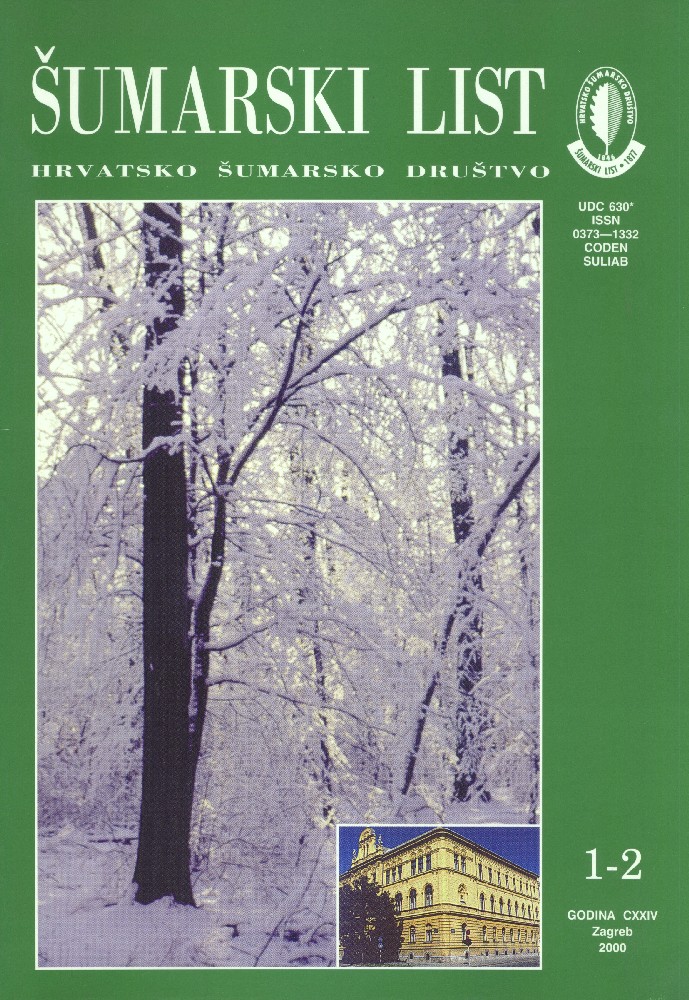
broj: 1-2/2000
pdf (35,1 MB) |
|
||||||||||||||
| PREGLEDNI ČLANCI | ||
| Martinić, I. | UDK 630* 377 + 461 | |
| Environmentally Friendly Use of Machinery in Forestry – a Soap Bubble or Near Future pdf HR EN | 3 | |
| Starčević, M. | UDK 630* 116 + 469 | |
| The Effects of Hydro-Melioration on Forest Vegetation of Varoški Lug pdf HR EN | 15 | |
| Summary: Depending on the micro-relief, ground and floodwater play a crucial role in the formation of forest associations of lowland regions. Lowland forests transpire more water than they receive from local precipitation, and the difference is compensated with ground or flood water. The smallest changes in the micro-relief related to the level of ground water causes changes in the soil type, floral composition and development of phytocoenosis.Hydro-melioration treatments bring about radical changes in the water regime, site conditions, soil types and natural vegetation, which often differs considerably from the previous one. In the last two decades forest ecosystems in Croatia have suffered badly from very aggressive anthropogenic influences, as well as from a series of dry years. The aim of this paper is to publish new, additional data on the effects of hydro-melioration treatments on the destabilisation of lowland forest ecosystems in Croatia. These data could serve as a starting point in searching for adequate solutions. In order to determine the present state of vegetation, phytocoenological recordings of the most common plant communities were made in four locations, which were selected on the basis of phytocoenological maps of the Management Unit Varoški Lug from 1977 and 1992. The method used was that of the Zurich-Montpellier Braun-Blanquete School. In the association of pedunculate oak and Genisto elatae, the humidity was determined by taking soil samples from various horizons up to the depth of 2 metres. The humidity degree as one of ecological indicators for site characterisation was calculated for each observed association according to Landolt. Research results show a change in the plant community ratio in favour of drier communities. In some parts of Varoški Lug, the association Genisto elatae-Quercetum roboris was succeeded by the association Carpino betuli-Quercetum roboris, and the floral composition and structure of normally developed sub-associations Genisto elatae-Quercetum roboris caricetosum remotae and Genisto elatae-Quercetum roboris caricetosum brizoides have deviated. Key words: changes; development of phytocoenosis; floral composition; formation of forest associations; ground and flood water; hydro-melioration treatments; lowland region; micro-relief; soil type | ||
| Domac, J. | UDK 630* 161 | |
| Face Project: Monitoring of Free-Air CO2 Enrichment Impact in Closed Canopy Deciduius Forest Projekt FACE: Die Beobachtung vom Einfluß der Luftbereicherung mit CO2 in dichter Beschirmung von Laubwäldern pdf HR EN | 27 | |
| Sabadi, R. | UDK 630* 791 + 799 | |
| Profile of Switzerland’s Forestry and Timber Industries in 1995 pdf HR EN | 33 | |
| Zelić, J. | UDK 630* 181.1 (Taxus baccata L.) | |
| Yew (Taxus baccata L.), a rare species in the mountains of Požega pdf HR EN | 41 | |
| STRUČNI ČLANCI | ||
| Potočić, N., Seletković, I. | UDK 630* 48 (Abies alba. Quercus robur, Fagus sylvatica) | |
| Croatia Forests Damage Status 1998 pdf HR EN | 51 | |
| Tuškan, S. | UDK 630* 242 | |
| The Role of Structure on Tending Stands with Thinning in Forest of Pedunculate Oak and Common Hornbeam (Querco roboris - Carpinetum illyricum, Anić) pdf HR EN | 57 | |


